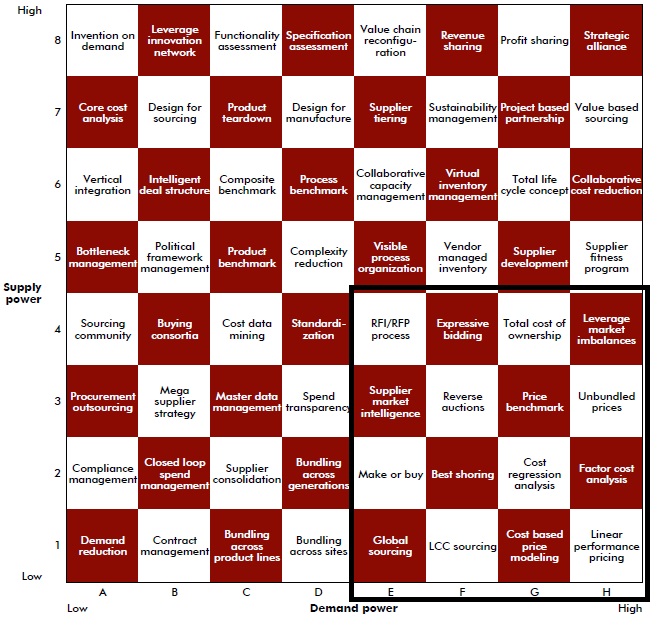Dear procurement professionals,
today we will consider the third sourcing strategy in situation where high demand power exists. So the third basic strategy is to leverage competition among suppliers to the advantage of the company. Variations of this strategy are further fueling competition through appropriate measures on the supplier market, or influencing supplier pricing through analytical tools.
The approaches for cutting costs and increasing value within this basic strategy are globalization, tendering, target pricing, and supplier pricing review.
These approaches and their underlying methods are briefly shown on the Purchasing chessboard of A.T.Kearney as follows:
Picture 1. The approaches for leverage competition among suppliers to the advantage of the company
Globalization
Globalization opens up possibilities not just on the selling side, but especially on the purchasing side. With the opening of markets in Eastern Europe, China and India, over a billion additional workers have become available globally; workers whose low factor costs are being increasingly paired with the highest levels of skill. However, utilizing the globalization lever means taking advantage not just of low-cost countries, but of the worldwide supplier market as well.
Globalization encompasses the following methods:
E1. Global sourcing: Global sourcing aims at selecting the most competitive suppliers worldwide. This may sound obvious, but it is still true today that European companies mostly use European suppliers and US companies mostly use US ones, whereby this ignominious list could be continued almost indefinitely.
E2. Make or buy: Except where core skills are concerned, internal production must be exposed to competition with the supplier market, and vice versa. Focusing attention on this topic often produces surprising results.
F1. LCC sourcing: Low-cost country sourcing is primarily aimed at identifying, assessing, and utilizing suppliers from countries with low factor costs.
F2. Best shoring: Best shoring aims at evaluating what region and what supplier are particularly suited for outsourcing within the value-creation process. Along with a business case analysis, this strategy also involves holistic assessment of risks.
Tendering
Probably the most commonly used approach is tendering. Although the effectiveness of tendering has declined since the end of the buyer’s market (at least for the time being), it would be a mistake to dismiss this approach.
Tendering is a particularly effective way of obtaining transparency regarding prices on the supplier market. Successful use of this approach requires expertise regarding the various steps of the tendering process, including identification of potential suppliers, preparation and mailing of the tender documents, analysis of bids, and negotiations with suitable
suppliers. The practice of tendering encompasses the following methods:E3. Supplier market intelligence: Supplier market intelligence comprises the systematic gathering, evaluation, and utilization of informationon all incumbent and potential new suppliers.
E4. RFI/RFP process: The RFI/RFP process encompasses the systematic preparation, dispatch, and evaluation of supplier information (RFI = request for information) and solicitations for offers (RFP = request for proposal).
F3. Reverse auctions: Through the use of web-based tools, reverse auctions can be used to accelerate the negotiating phase of the tendering process.
F4. Expressive bidding: Expressive bidding refers to obtaining supplier offers while allowing for “if-then” conditions (e.g. delivery period, service levels).
Target pricing
Since only very few suppliers are prepared to disclose their cost structures, the use of the target pricing lever will require alternative ways of determining cost structures. Depending on the initial situation, methods of varying analytical depth can be used to ascertain target prices. Some of these methods call for expertise in statistics. Target pricing encompasses the following
methods:G1. Cost based price modeling: Cost based price modeling is a process-oriented method for determining target prices. The bases for target prices are the individual process steps, to which reference values can be applied.
G2. Cost regression analysis: Cost regression analysis is a statistical method for determining target prices on the basis of several technical parameters.
H1. Linear performance pricing: Linear performance pricing is a method for identifying the main technical cost driver for the product price of a group of materials.
H2. Factor cost analysis: Factor cost analysis is a method for systematically identifying, analyzing, and comparing relevant factor costs. It can be used as the basis for comparing the factor costs of various suppliers and thus determining target prices.
Supplier pricing review
Quite often, the prices of existing suppliers are not systematically calculated on the basis of “cost-plus” logic. Development or tooling costs are usually factored in inconsistently, and mixed costing robs pricing of its transparency. Supplier pricing review introduces uniform standards for pricing. Supplier pricing review encompasses the following methods:
G3. Price benchmark: Price benchmark is a method of comprehensive comparison of product prices and contract terms.
G4. Total cost of ownership: This concept comprises the holistic identification, evaluation, and analysis of non-recurring costs, production costs, transport costs, complexity costs, and operating costs.
H3. Unbundled prices: Unbundled prices aim at breaking down the total price of a product or service into the relevant cost elements (e.g. component vs. system costs, production vs. development costs), in order to invite separate bids for each of these elements during a tendering process.
H4. Leverage market imbalances: In this method, the aim is to systematically identify market imbalances and exploit them for purchasing purposes. Market imbalances can come about as a result of variable capacity utilization across certain regions, differing price mechanisms, or fluctuations in factor costs.


